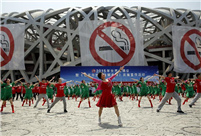

BEIJING, April 17 -- The health of China's rivers is due for a thorough examination, as an action plan for pollution control goes on stream.
A State Council plan on water pollution, released on Thursday, aims to reduce pollutants and protect resources through new, strictly quantifiable targets.
Over 70 percent of the water in the basins of China's seven major rivers should be in "good" condition by 2020. The target applies to the Yangtze, Yellow, Zhujiang, Songhuajiang, Huai, Hai and Liao rivers.
Over the last few decades, industrialization, urbanization and rapid population growth have taken their toll on China's already rare freshwater resources. Half of China's major rivers and around40 percent of important lakes are polluted.
The action plan is just one small step in the right direction, but it won't be easy to clean up China's "most polluted."
The Hai River in the heart of Tianjin Municipality is among the worst. According to a 2013 report by the city, 72.7 percent of water in the Tianjin section is "bad." Zhang Kai of a Tianjin hydrology institute said the river suffers from a severe water shortage.
"Per capita resources along the river have been just over 100 cubic meters for years, compared to 300 in Israel, a country famous for water shortages. Quantity and quality of water are closely related," he said.
Former chief Tianjin environmental protection engineer Bao Jingling said, "The small amount of water has led to accumulation of industrial, agricultural and household pollution in the river basin. The pollution is often washed into the city streets by torrential rain."
Pollution control on the river has been obstructed by a lack of collaboration between government departments. An unwritten rule states that water departments deal with problems of water, while the environmental protection departments take charge of pollution on the shore. When pollution in a waterway originates on the riverbank, the division of responsibility is problematic.
The 1,000-km Huai, which crosses five provinces, has been classified as "severely polluted" since the 1990s. Thanks to a national pollution control campaign in place for 20 years, water quality has improved somewhat, but the situation remains grave.
Wang Jiaquan of Hefe University of Technology in Anhui Province said that while water in the main stream of the Huai has become clearer, tributaries and lakes have not received enough attention, so parts of the river are still in a poor state.
On a recent fact-finding mission, a Xinhua reporter visited a tributary of the Huai in Anhui and found it covered in white foam and dead weeds with a foul smell. Local farmers said the smell is especially bad in summer and people who wade in the river develop a red rash.
The problem is nationwide. The main streams of rivers are often given more attention than tributaries and lakes. It will be important to attach just as much importance to tributaries in order to hit the new targets, Wang said.
"The response of the local governments to the plan matters," he said. "Can local authorities come up with detailed and feasible policies?"
 J-11 fighters in air exercise
J-11 fighters in air exercise Beauties dancing on the rings
Beauties dancing on the rings Attendants-to-be join Mr. & Miss Campus Contest
Attendants-to-be join Mr. & Miss Campus Contest Beijing's toughest anti-smoking law takes effect
Beijing's toughest anti-smoking law takes effect Family lives in cave for about 50 years in SW China
Family lives in cave for about 50 years in SW China PLA soldiers operating vehicle-mounted guns in drill
PLA soldiers operating vehicle-mounted guns in drill Blind carpenter in E China's Jiangxi
Blind carpenter in E China's Jiangxi China hosts overseas disaster relief exercise for the first time
China hosts overseas disaster relief exercise for the first time 20 pairs of twins who will become flight attendants in Sichuan
20 pairs of twins who will become flight attendants in Sichuan Obama is sowing discontent in S.China Sea
Obama is sowing discontent in S.China Sea Rescuers work through night to reach cruise ship survivors
Rescuers work through night to reach cruise ship survivors Driving through limbo
Driving through limbo Facing down MERS
Facing down MERSDay|Week